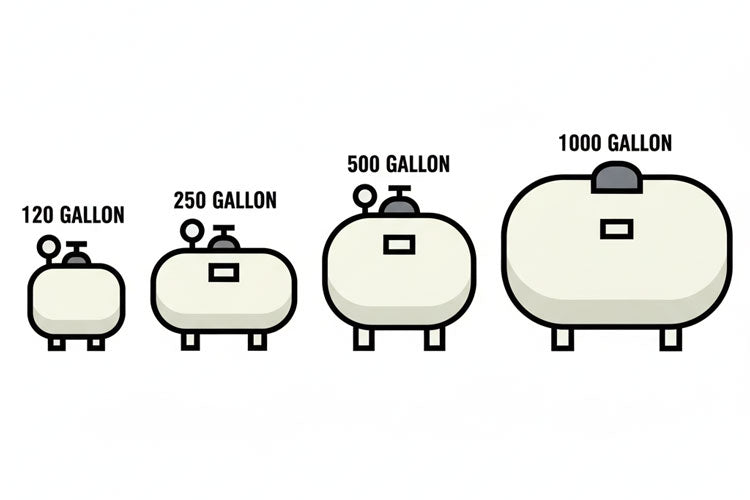This guide provides sizes and usage for the most common propane tanks for home use. Based on the common uses and factors for choosing a propane tank, here are three examples to help you select the right size for a typical home:
Example 1: The "Minimalist" Propane Home
- Scenario: A 1,500 sq. ft. house in a moderate climate. The home's primary heat source is electric, but propane is used for a few specific appliances.
- Propane Appliances: A gas cooktop, a clothes dryer, and a tankless water heater.
- Recommendation: A 120-gallon propane tank. This size is perfect for homes with a small number of propane-powered appliances. It's large enough to supply these items for several months, so you won't need frequent refills. It's a great choice for supplemental use without the need for a large, obtrusive tank.
Example 2: The "Standard" Propane Home
- Scenario: A 2,500 sq. ft. home in a region with cold winters. Propane is the main energy source for heating and other household functions.
- Propane Appliances: A central furnace, a water heater, a cooktop, and a fireplace.
- Recommendation: A 500-gallon propane tank. This is the most common size for all-propane homes because it can handle the significant demand of a central heating system, especially during the colder months. A 500-gallon tank can typically last a family through an entire winter without needing a refill, provided the usage is standard. It strikes a good balance between capacity and physical size.
Example 3: The "High-Demand" Propane Home
- Scenario: A large, 4,500 sq. ft. custom-built house in a cold climate. The home is fully dependent on propane for energy, and it has several high-BTU appliances.
- Propane Appliances: Two central furnaces for zoned heating, a tankless water heater, a cooktop, a large outdoor kitchen grill, and a backup generator.
- Recommendation: A 1,000-gallon propane tank. For a home with this level of demand, a 1,000-gallon tank is essential. The two furnaces and backup generator alone consume a significant amount of fuel. This size ensures the home stays warm and functional through extended cold periods or power outages without the need for emergency or very frequent refills. It's the most practical and efficient choice for a high-usage situation.
How to Choose the Right Tank Size
When deciding on a propane tank, it's essential to consider a few key factors to ensure you have enough fuel for your home's needs:
- Number and Type of Appliances: List every appliance you will be running on propane. Appliances like central heating and generators have a much higher BTU (British Thermal Unit) rating and will use more fuel than a cooktop or clothes dryer.
- Usage Frequency: Think about how often and for how long you'll use your propane appliances. For example, a fireplace used occasionally will have a much lower impact on your fuel level than a furnace that runs daily in the winter.
- Refill Frequency: A larger tank means fewer refills. While a smaller tank may be cheaper upfront, you might find yourself needing more frequent—and potentially more expensive—deliveries. Choosing a larger tank gives you the convenience of fewer service calls.
- Consult a Professional: A propane supplier is your best resource. They can conduct a full assessment of your home's square footage, climate, and appliance usage to accurately calculate your specific BTU requirements. This will help you choose a tank size that is both safe and cost-effective.
The Right Size Makes All the Difference
Choosing the correct propane tank size ensures your home stays warm, your appliances run efficiently, and you aren’t constantly scheduling refills. Whether you’re outfitting a minimalist setup or fueling a high-demand home, the right tank can save you time, money, and stress. Once your tank is in place, don’t forget to protect it—especially the dome. A ProDomeSeal keeps pests and moisture out, helping your system run smoothly for the long haul.


Leave a comment: